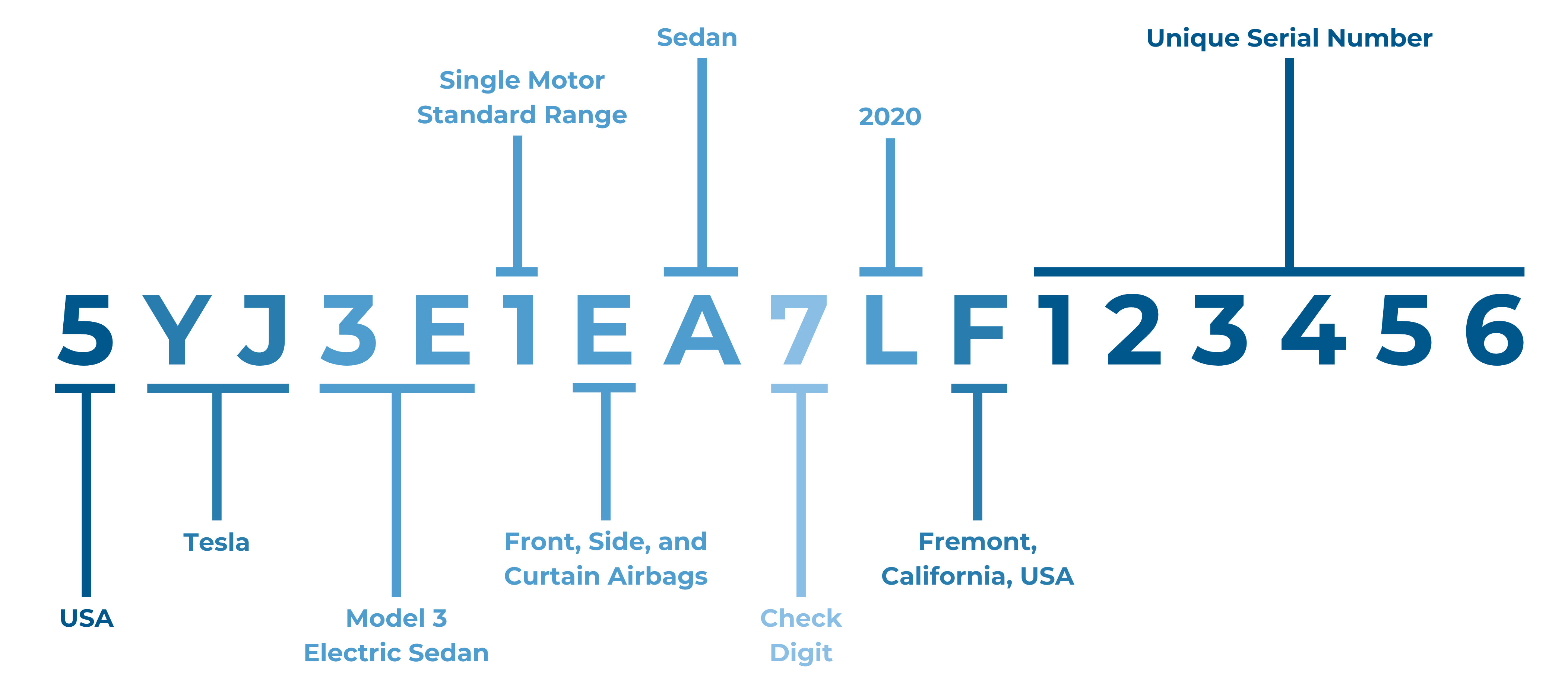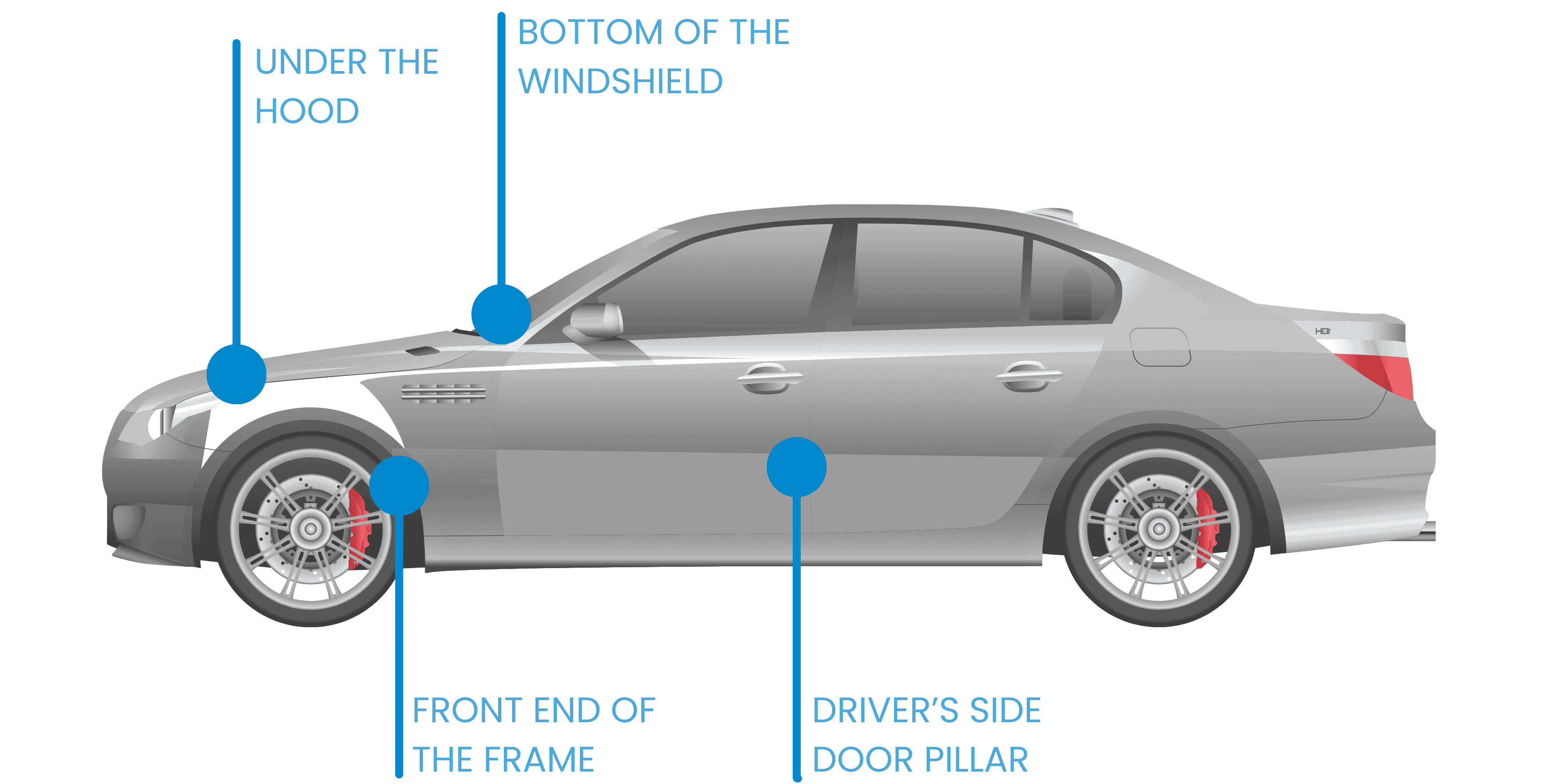What is the structure of a Vehicle Identification Number?
Before decoding VIN numbers, it’s important to understand how they’re built. A Vehicle Identification Number (VIN) is a 17-character code. Think of it as your car’s fingerprint—no two vehicles share the same one. Use the decoder to interpret VIN structure and discover what each part of the code reveals. You’ll find key details about the manufacturer, model, engine type, and even the production line.
Every section of the VIN tells a different story. When you break it down, you can learn a lot about any car.
| Position |
Description |
| 1–3 |
WMI (World Manufacturer Identifier) |
| 4–8 |
Vehicle Descriptor Section (model, engine, etc.) |
| 9 |
Check Digit (VIN integrity validation) |
| 10 |
Model Year |
| 11 |
Plant Code |
| 12–17 |
Serial Number |
As the vin number decoding chart shows, each VIN section follows a standard layout set back in 1979 and 1980. These guidelines make decoding VIN numbers much easier. Whether you’re confirming a car’s identity or digging into its background, this chart gives you a clear roadmap.
Characters 1-3: World Manufacturer Identifier (WMI)
The WMI shows where a vehicle was made and who built it. The first character tells you the country of origin. The second shows the vehicle type or manufacturer’s division. The third points to the model or factory.
By learning how to read the WMI, you can easily use a vin number decoding chart to find key details about the manufacturer.
| WMI |
Region |
Notes |
| A-C |
Africa |
AA-AH = South Africa |
| J-R |
Asia |
J = Japan |
| KL-KR = South Korea |
| L = China |
| MA-ME = India |
| MF-MK = Indonesia |
| ML-MR = Thailand |
| MS = Myanmar |
| NL-NR = Turkey |
| PA-PE = Philippines |
| PL-PR = Malaysia |
| RF-RG = Taiwan |
| S-Z |
Europe |
SA-SM = United Kingdom |
| SN-ST, W = Germany |
| SU-SZ = Poland |
| TA-TH = Switzerland |
| TJ-TP = Czech Republic |
| TR-TV = Hungary |
| TW-T1 = Portugal |
| VA-VE = Austria |
| VF-VR = France |
| VS-VW = Spain |
| VX-V2 = Yugoslavia |
| XL-XM = The Netherlands |
| XS-XW = USSR |
| X3-X0 = Russia |
| YA-YE = Belgium |
| YF-YK = Finland |
| YS-YW = Sweden |
| ZA-ZR = Italy |
| 1-5 |
North America |
1, 4, 5 = United States |
| 2 = Canada |
| 3 = Mexico |
| 6-7 |
Oceania |
6A-6W = Australia |
| 7A-7E = New Zealand |
| 8-9 |
South America |
8A-8E = Argentina |
| 8F-8J = Chile |
| 8L-8R = Ecuador |
| 8X-82 = Venezuela |
| 9A-9E, 93-99 = Brazil |
| 9F-9J = Colombia |
Characters 4-8: Vehicle Descriptor Section (VDS)
The VDS gives more details about the car. It tells you things like the body type, engine, trim, and other unique features. This section can look different from one car brand to another.
- Model Information: This part shows the model name or a short code that tells you which model it is.
- Body Style: It tells you if the car is a sedan, SUV, truck, coupe, or convertible.
- Engine Type: You’ll find out if the car uses a V engine, inline engine, diesel, or something else.
- Trim Level: This shows different versions of the same model. Some may have extra features or special options.
- Other Vehicle Specifics: Some car makers add extra info here. That might include safety tech, special packages, or unique equipment.
Every car maker uses the VDS in their own way. Because of that, the codes are not the same across all brands.
Character 9: Check Digit
The 9th character in a VIN is called the Check Digit. It plays a key role in making sure the VIN is correct and trustworthy. A special math formula checks the other 16 characters and turns them into one digit (0–9) or the letter “X.”
This digit helps spot mistakes like typing errors. It also blocks fraud by confirming that no one has changed the VIN. Because of this, the Check Digit protects buyers and sellers. It makes sure the VIN stays accurate before anyone uses it for sales or official records.
Character 10: Vehicle Identification Section – Model Year
The 10th character represents the model year of a car.
| Code |
Year |
Code |
Year |
Code |
Year |
| A |
1980 |
X |
1999 |
J |
2018 |
| B |
1981 |
Y |
2000 |
K |
2019 |
| C |
1982 |
1 |
2001 |
L |
2020 |
| D |
1983 |
2 |
2002 |
M |
2021 |
| E |
1984 |
3 |
2003 |
N |
2022 |
| F |
1985 |
4 |
2004 |
P |
2023 |
| G |
1986 |
5 |
2005 |
R |
2024 |
| H |
1987 |
6 |
2006 |
S |
2025 |
| J |
1988 |
7 |
2007 |
T |
2026 |
| K |
1989 |
8 |
2008 |
V |
2027 |
| L |
1990 |
9 |
2009 |
W |
2028 |
| M |
1991 |
A |
2010 |
X |
2029 |
| N |
1992 |
B |
2011 |
Y |
2030 |
| P |
1993 |
C |
2012 |
1 |
2031 |
| R |
1994 |
D |
2013 |
2 |
2032 |
| S |
1995 |
E |
2014 |
3 |
2033 |
| T |
1996 |
F |
2015 |
4 |
2034 |
| V |
1997 |
G |
2016 |
5 |
2035 |
| W |
1998 |
H |
2017 |
6 |
2036 |
Character 11: Assembly Plant
The 11th character in a Vehicle Identification Number (VIN) shows the assembly plant. Each letter or number in this spot stands for a different assembly plant.
Here’s a quick reference table with assembly plant codes used by popular vehicle makers in the United States:
| Manufacturer |
Assembly Plant Code |
Plant Location |
Example VIN |
| Ford |
K |
Kansas City, Missouri, USA |
1FTRX18L3YKK12830 |
| Toyota |
0 |
Toyota City, Aichi Prefecture, Japan |
JTDBT923641029318 |
| Honda |
A |
Marysville, Ohio, USA |
1HGCM82633AA173820 |
| BMW |
N |
Spartanburg, South Carolina, USA |
5UXWX9C52EN345678 |
| Hyundai |
U |
Ulsan, South Korea |
KMHGC4DE6DUU152387 |
| Chevrolet |
Z |
Fort Wayne, Indiana, USA |
1GCNCPEA4CZZ123456 |
| Tesla |
F |
Fremont, California, USA |
5YJSA1CN0CF158324 |
| Volkswagen |
W |
Wolfsburg, Germany |
WVWZZZ3BZAEW123456 |
Why Character 11 Matters
- Quality Control: Different factories have different track records. Some are known for great quality, while others might have more problems. Knowing the plant can help identify trends in performance or recalls.
- Authenticity Verification: Ensures the VIN matches the expected manufacturing location. It’s a way to check if the vehicle is real and not tampered with.
- Collector Insight: Some plants make special or high-quality models. Car fans and collectors use this info to find rare or well-made vehicles.
This single character gives clear clues about where the car was made. It helps with research, resale, and even planning repairs.
Characters 12-17 (VIS): Vehicle Identifier Section
The last six characters of a VIN make up the Vehicle Identifier Section (VIS). This section works like a serial number and sets each vehicle apart from the rest. Even if two cars share the same make and model, their VIS will still be different. In many cases, lower numbers in the VIS show that the car was built earlier on the production line.
You’ll need the VIS for several important things. It helps with vehicle registration, title paperwork, repair and service history, recall checks, and tracking specific cars. Each VIS plays a key role in identifying a unique vehicle.
Example VIN Breakdown

- Position 1: Country of Origin (J = Japan)
- Position 2 – 3: Manufacturer (HM = Honda, Passenger Car)
- Position 4 – 5: Vehicle Type (CP = Accord Sedan)
- Position 6: Engine Type (2 = 2.4L Inline-4, gasoline)
- Position 7: Restraint System (6 = Dual front airbags)
- Position 8: Body Type (4 = 4-Door Sedan)
- Position 9: Verifies VIN integrity (4 = Check Digit)
- Position 10: Model Year (9 = 2009)
- Position 11: Assembly Plant (C = Sayama, Japan)
- Position 12 – 17: Vehicle Identifier Section (013634= Serial number or production sequence number)

- Position 1: Country of Origin (5 = USA)
- Position 2 – 3: Manufacturer (YJ = Tesla)
- Position 4 – 5: Vehicle Type (3E = Model 3 Electric Sedan)
- Position 6: Engine Type (1 = Single Motor Standard Range)
- Position 7: Restraint System (E = Front, Side, and Curtain Airbags)
- Position 8: Body Type (A = Sedan)
- Position 9: Verifies VIN Integrity (7 = Check Digit)
- Position 10: Model Year (L = 2020)
- Position 11: Assembly Plant (F = Fremont, California, USA)
- Position 12 – 17: Vehicle Identifier Section (123456 = Unique Serial Number)


